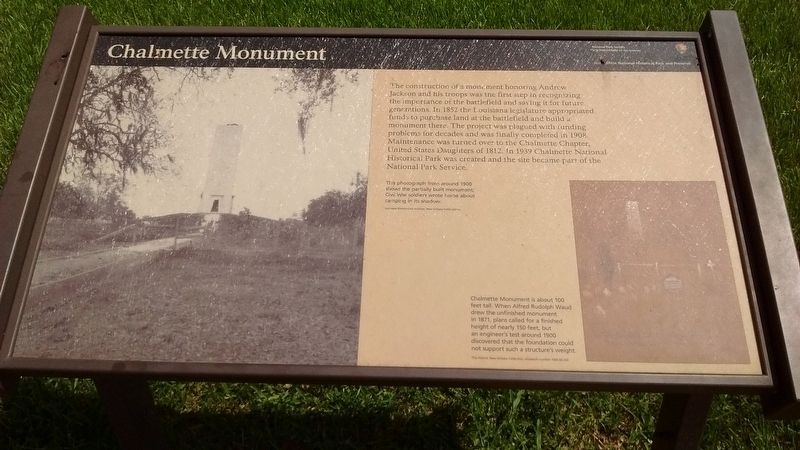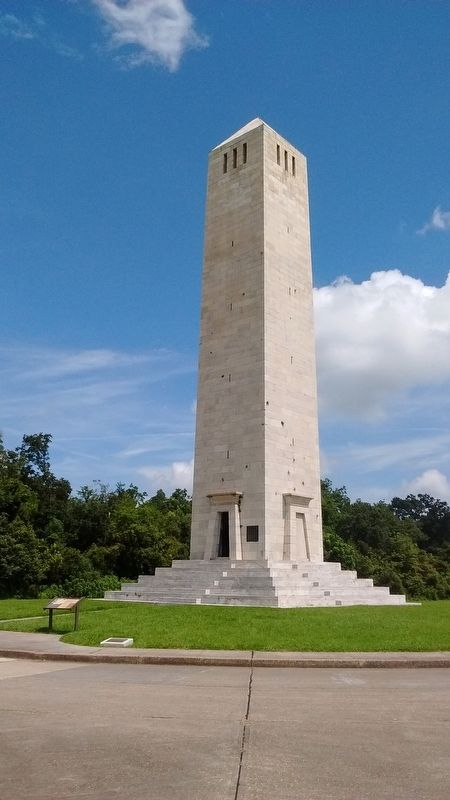Chalmette in St. Bernard Parish, Louisiana — The American South (West South Central)
Chalmette Monument
Jean Lafitte National Historical Park and Preserve
— National Park Service, U.S. Department of the Interior —
(captions)
This photograph from around 1900 shows the partially built monument; Civil War soldiers wrote home about camping in its shadow.
Chalmette Monument is about 100 feet tall. When Alfred Rudolph Waud drew the unfinished monument in 1871, plans called for a finished height of nearly 150 feet, but an engineer's test around 1900 discovered that the foundation could not support such a structure's weight.
Erected by National Park Service, U.S. Department of the Interior.
Topics and series. This historical marker and monument is listed in this topic list: War of 1812. In addition, it is included in the Former U.S. Presidents: #07 Andrew Jackson series list. A significant historical year for this entry is 1852.
Location. 29° 56.538′ N, 89° 59.65′ W. Marker is in Chalmette, Louisiana, in St. Bernard Parish. Marker is at the intersection of Chalmette National Park Scenic Rd (Battlefield Rd) and Chalmette National Park Scenic Rd (Tour Loop Rd), in the median on Chalmette National Park Scenic Rd (Battlefield Rd). The Chalmette National Park Scenic Road, or Battlefield Road, is located within the Chalmette Battlefield portion of the Jean Lafitte National Historical Park and Preserve. Touch for map. Marker is in this post office area: Chalmette LA 70043, United States of America. Touch for directions.
Other nearby markers. At least 8 other markers are within walking distance of this marker. 7th U.S. Infantry - 44th U.S. Infantry (here, next to this marker); Choctaw Nation (a few steps from this marker); U.S. Marines (a few steps from this marker); a different marker also named Chalmette Monument (a few steps from this marker); Tennessee Militia (a few steps from this marker); U.S. Navy (a few steps from this marker); Kentucky Militia (within shouting distance of this marker); Louisiana Militia (within shouting distance of this marker). Touch for a list and map of all markers in Chalmette.
Also see . . . Chalmette Battlefield. https://www.nps.gov/places/chalmette-battlefield.htm NPS Jean Lafitte National Historical Park and Preserve website entry (Submitted on August 24, 2016, by Tom Bosse of Jefferson City, Tennessee.)
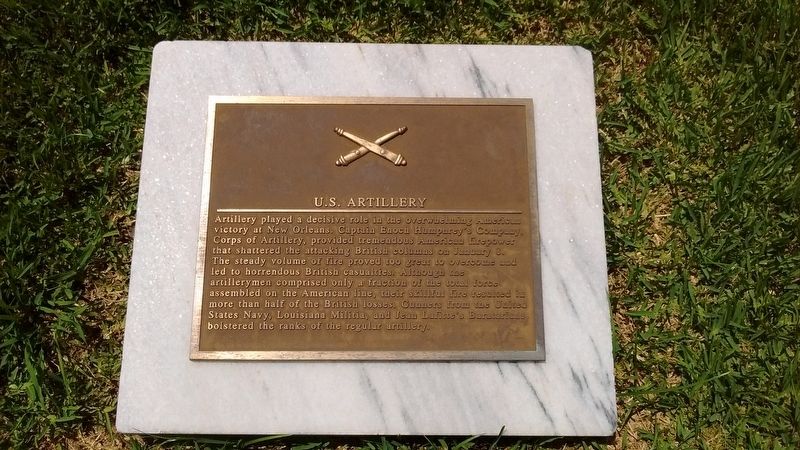
Photographed By Tom Bosse, July 31, 2016
3. U.S. Artillery
Artillery played a decisive role in the overwhelming American victory at New Orleans. Captain Enoch Humphrey's Company, Corps of Artillery, provided tremendous American firepower that shattered the attacking British columns on January 8. The steady volume of fire proved too great to overcome and led to horrendous British casualties. Although the artillerymen comprised only a fraction of the total force assembled on the American line, their skillful fire resulted in more than half of the British losses. Gunners from the United States Navy, Louisiana Militia, and Jean Lafitte's Baratarians bolstered the ranks of the regular artillery.
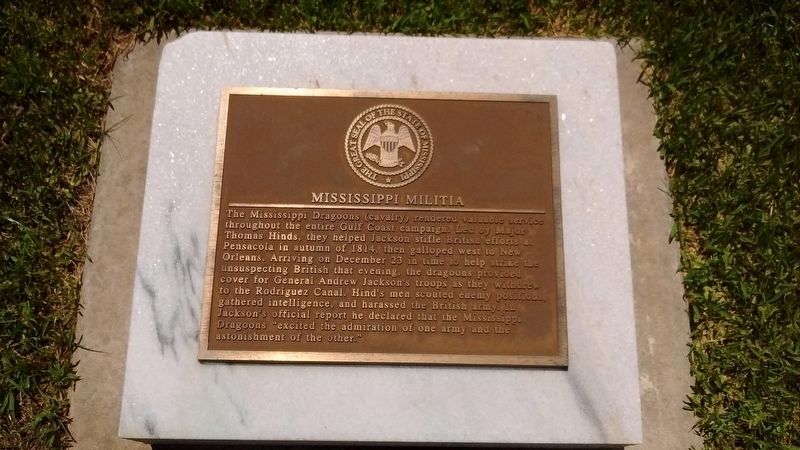
Photographed By Tom Bosse, July 31, 2016
4. Mississippi Militia
The Mississippi Dragoons (cavalry) rendered valuable service throughout the entire Gulf Coast campaign. Led by Major Thomas Hinds, they helped Jackson stifle British efforts at Pensacola in autumn 1814, then galloped west to New Orleans. Arriving on December 23 in time to help strike the unsuspecting British that evening, the dragoons provided cover for General Andrew Jackson's troops as they withdrew to the Rodriguez Canal. Hind's men scouted enemy positions, gathered intelligence, and harassed the British army. In Jackson's official report he declared that the Mississippi Dragoons "excited the admiration of one army and the astonishment of the other."
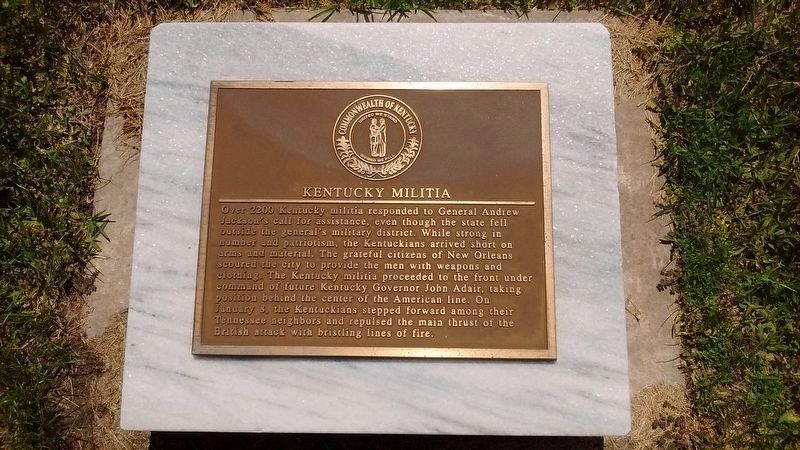
Photographed By Tom Bosse, July 31, 2016
5. Kentucky Militia
Over 2200 Kentucky militia responded to General Andrew Jackson's call for assistance, even though the state fell outside the general's military district. While strong in number and patriotism, the Kentuckians arrived short on arms and material. The grateful citizens of New Orleans scoured the city to provide the men with weapons and clothing. The Kentucky militia proceeded to the front under command of future Kentucky Governor John Adair, taking position behind the center of the American line. On January 8, the Kentuckians stepped forward among their Tennessee neighbors and repulsed the main thrust of the British attack with bristling lines of fire.
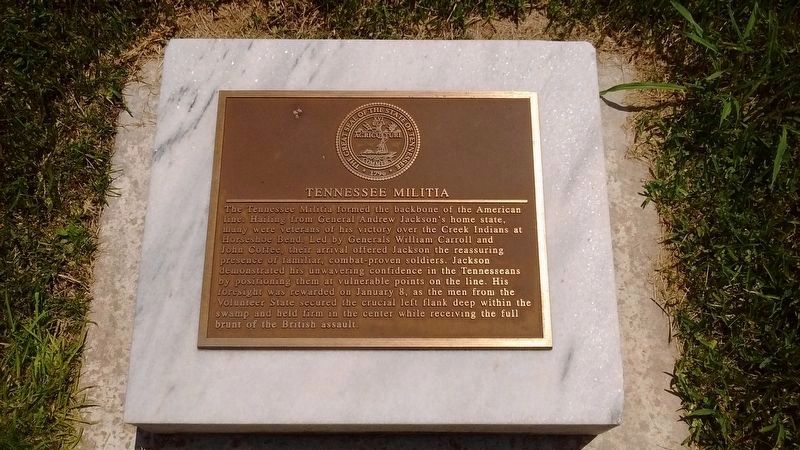
Photographed By Tom Bosse, July 31, 2016
6. Tennessee Militia
The Tennessee Militia formed the backbone of the American line. Hailing from General Andrew Jackson's home state, many were veterans of his victory over the Creek Indians at Horseshoe Bend. Led by Generals William Carroll and John Coffee, their arrival offered Jackson the reassuring presence of familiar, combat-proven soldiers. Jackson demonstrated his unwavering confidence in the Tennesseans by positioning them at vulnerable points on the line. His foresight was rewarded on January 8, as the men from the Volunteer State secured the crucial left flank deep within the swamp and held firm in the center while receiving the full brunt of the British assault.
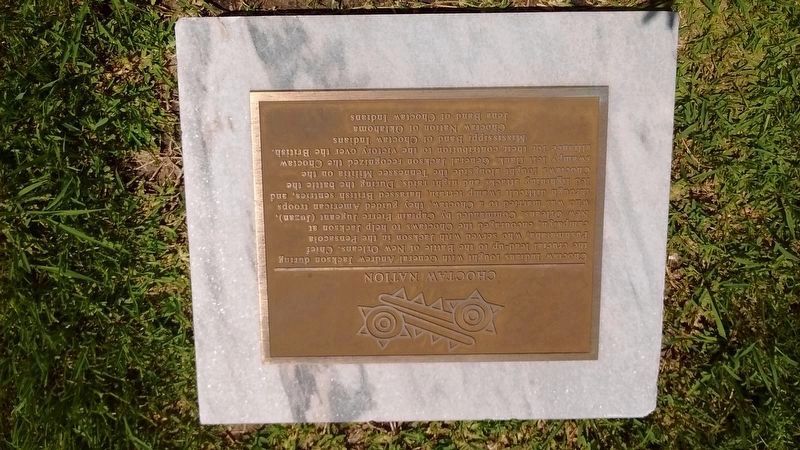
Photographed By Tom Bosse, July 31, 2016
7. Choctaw Nation
Choctaw Indians fought with General Andrew Jackson during the crucial lead-up to the Battle of New Orleans. Chief Pushmataha, who served with Jackson in the Pensacola campaign, encouraged the Choctaws to help Jackson at New Orleans. Commanded by Captain Pierre Jugeant (Juzan), who was married to a Choctaw, they guided American troops through difficult swamp terrain, harassed British sentries, and led lightning attacks and night raids. During the battle the Choctaws fought alongside Tennessee Militia on the swampy left flank. General Jackson recognized the Choctaw alliance for their contribution to the victory over the British.
Mississippi Band of Choctaw Indians
Choctaw Nation of Oklahoma
Jena Band of Choctaw Indians
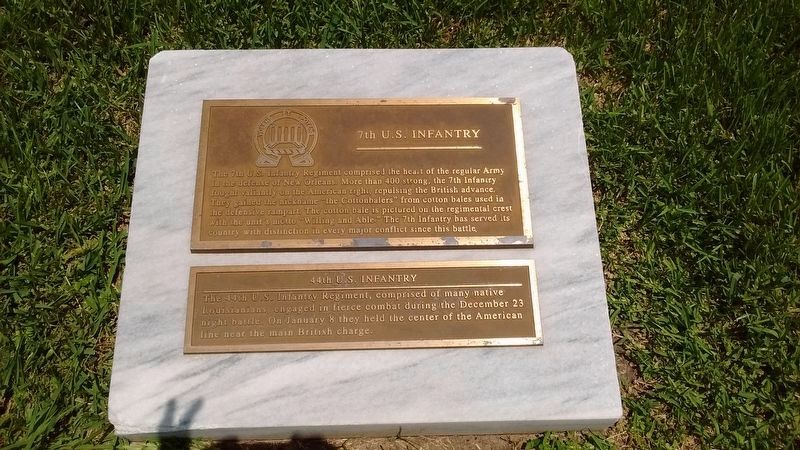
Photographed By Tom Bosse, July 31, 2016
8. 7th U.S. Infantry / 44th U.S. Infantry
The 7th U.S. Infantry Regiment comprised the heart of the regular army in the defense of New Orleans. More than 400 strong, the 7th Infantry fought valiantly on the American right, repulsing the British advance. They gained the nickname "the Cottonbalers" from the cotton bales used in the defensive rampart. The cotton bale is picture on the regimental crest with the unit's motto "Willing and Able". The 7th Infantry has served its country with distinction in every major conflict since this battle.
The 44th U.S. Infantry Regiment, comprised of many native Louisianians, engaged in fierce combat during the December 23 night battle. On January 8 they held the center of the American line near the main British charge.
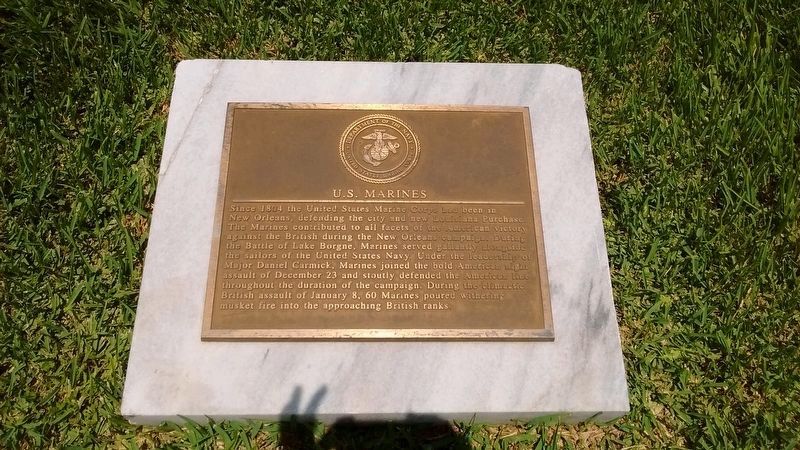
Photographed By Tom Bosse, July 31, 2016
9. U.S. Marines
Since 1804 the United States Marine Corps had been in New Orleans, defending the city and new Louisiana Purchase. The marines contributed to all facets of the American victory against the British during the New Orleans campaign. During the Battle of Lake Borgne, marines served gallantly alongside the sailors of the United States Navy. Under the leadership of Major Daniel Carmick, Marines joined the bold American night assault of December 23 and stoutly defended the American line throughout the duration of the campaign. During the climactic British assault of January 8, 60 Marines poured withering musket fire into the approaching British ranks.
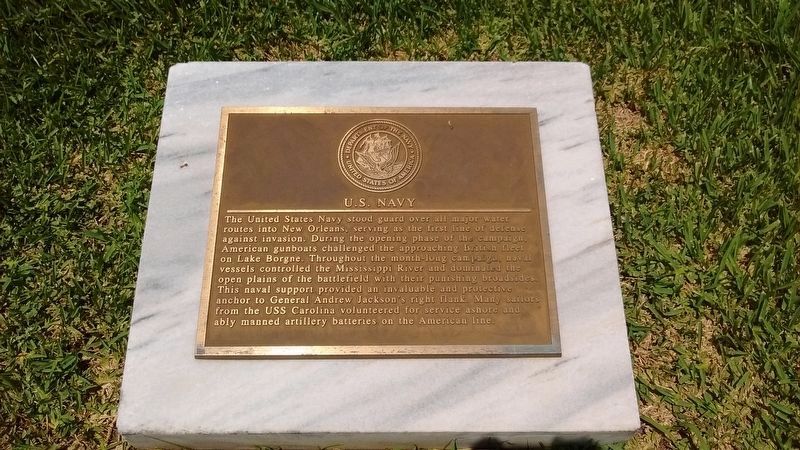
Photographed By Tom Bosse, July 31, 2016
10. U.S. Navy
The United States Navy stood guard over all major water routes into New Orleans, serving as the first line of defense against invasion. During the opening phase of the campaign, American gunboats challenged the approaching British fleet on Lake Borgne. Throughout the month-long campaign, naval vessels controlled the Mississippi River and dominated the open plains of the battlefield with their punishing broadsides. This naval support provided an invaluable and protective anchor to General Andrew Jackson's right flank. Many sailors from the USS Carolina volunteered for service ashore and ably manned artillery batteries on the American line.
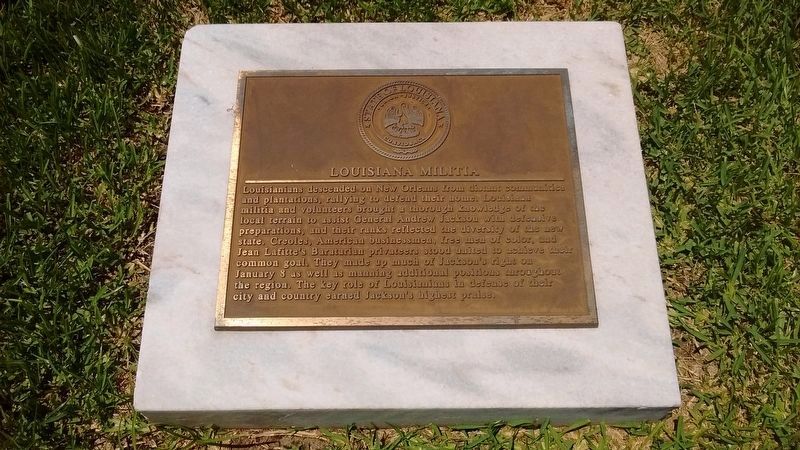
Photographed By Tom Bosse, July 31, 2016
11. Louisiana Militia
Louisianians descended on New Orleans from distant communities and plantations, rallying to defend their home. Louisiana militia and volunteers brought a thorough knowledge of the local terrain to assist General Andrew Jackson with defensive preparations, and their ranks reflected the diversity of the new state. Creoles, American businessmen, free men of color, and Jean Lafitte's Baratarian privateers stood united to achieve their common goal. They made up much of Jackson's right on January 8 as well as manning additional positions throughout the region. The key role of Louisianians in defense of their city and country earned Jackson's highest praise.
Credits. This page was last revised on January 12, 2022. It was originally submitted on August 24, 2016, by Tom Bosse of Jefferson City, Tennessee. This page has been viewed 1,166 times since then and 65 times this year. It was the Marker of the Week January 7, 2018. Photos: 1, 2, 3, 4. submitted on August 24, 2016, by Tom Bosse of Jefferson City, Tennessee. 5, 6, 7. submitted on December 10, 2016, by Tom Bosse of Jefferson City, Tennessee. 8, 9, 10. submitted on December 13, 2016, by Tom Bosse of Jefferson City, Tennessee. 11. submitted on December 14, 2016, by Tom Bosse of Jefferson City, Tennessee. • Bernard Fisher was the editor who published this page.
